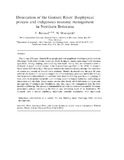Desiccation of the Gomoti River: Biophysical process and indigenous resource management in Northern Botswana

View/
Date
2005Author
Bernard, T.
Moetapele, N.
Publisher
Elsevier http://www.doi:10.1016/j.jaridenv.2005.02.001Type
Published ArticleMetadata
Show full item recordAbstract
For at least 200 years, Gomoti River people and their neighbours lived interactively with the Okavango flood pulse system, travelling widely in dugout canoes, practicing flood recession agriculture, fishing, hunting, and collecting wild foods. Today they are wetlanders without wetlands. A major outflow channel of the eastern Okavango Delta in the 1930s, the Gomoti River rarely flows these days. This paper explores the Gomoti’s demise, through the lenses first of science and second of Gomoti basin residents. Models developed over the past 20 years attribute the Gomoti’s drying to a complex set of bio-hydrologic processes and feedback loops
that begin with sedimentation and conclude with channel switching, peat fires, and purging of toxic salts. Such models essentially omit the long history of human habitation and ecological
interaction with the delta. Local people, on the other hand, tell of deliberate and systematic management of channels and floodplains, and they argue this management kept the river
healthy and flowing. The picture is confounded by colonial era interventions and by Botswana
government policies partitioning the Gomoti and restricting access to its headwaters. We conclude with a model combining meso-scale scientific explanation with micro-scale indigenous constructions as a context for new thinking about Okavango Delta resource management.
